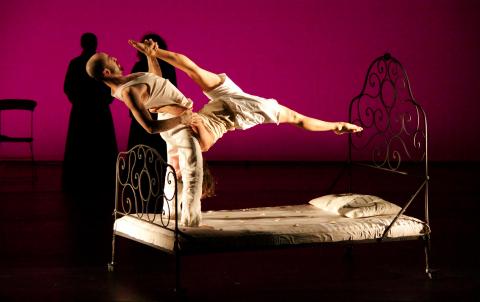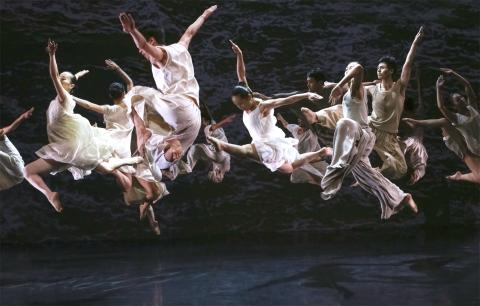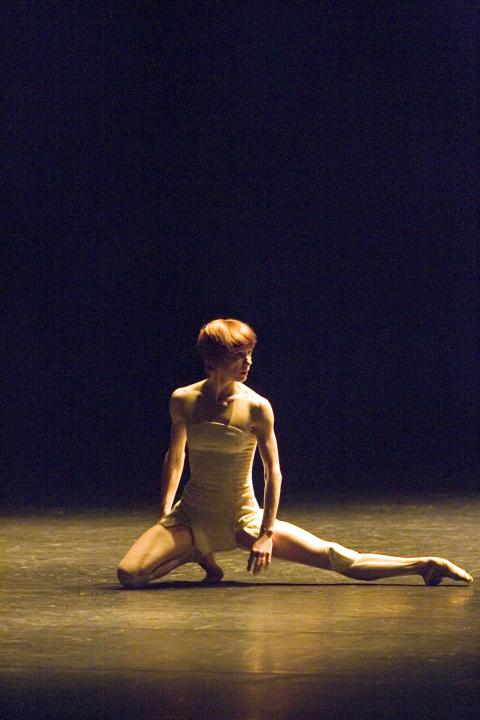There were some extraordinary performances in the world of dance this year from both Taiwanese and foreign dancers and troupes, as well as the opportunity to see works by choreographers who had previously not been seen in this county.
Coincidentally, Switzerland-based artists top the list: the wildly inventive Lugano-based Compagnia Finzi Pasca and French prima ballerina turned contemporary dancer Sylvie Guillem.
‘DONKA’ top show

Photo courtesy of the National Theater Concert Hall
Technically, Compagnia Finzi Pasca should not be in this column, much less heading the list; it is a theater company, not a dance troupe. However, its Donka — A Letter to Chekhov was simply the most amazing show this reviewer saw this year, plus movement and choreography are key elements to the company’s performances.
Director Daniele Finzi Pasca wrote, directed, choreographed and lit Donka , which combines elements of circus, dance and theater, while Maria Bonzanigo did the score, sound design and some choreography as well. The production is breathtaking.
Guillem also takes your breath away and Taipei audiences not only had their first chance to see the 49-year-old dancer, but a second and most-likely last chance to see her as well. She came in April to do two performances of her 6000 Miles Away program at the National Theater, and then returned in September with British dancer/choreographer Russell Maliphant for their show Push. In November, she announced that she would retire at the end of next year.

Photo courtesy of Liu Chen-hsiang
Having only seen Guillem in film and YouTube clips, the chance to see her dance in person was not to be missed. While both shows were strong, Push made for a more lasting impression, both of the two dancers and of Maliphant’s choreography, which this reviewer has been longing to see for quite a while.
As it fate would have it, Taipei audiences had yet another chance to see more of Maliphant’s work, when Yilan County-borne Sheu Fang-yi (許芳宜) and Chinese ballerina Tan Yuanyuan (譚元元) brought their 2X2 program to the National Theater at the end of October. Their performances in the duet 2X2 were just as amazing as Guillem had been in the solo version of the work, Two, just a few weeks earlier.
Maliphant is not the only contemporary choreographer whose works have been missing from Taiwan’s stages for too long. American renaissance man Mark Morris had been a glaring absence, but one that was remedied in June.

Photo courtesy of Bill Cooper
Another company that made a belated debut this year was the Beijing-based TAO Dance Theater (陶身體劇場). The five-year-old company had been set to make its Taipei premiere in the Novel Hall Dance Series in 2012, but an injury to a dancer forced it to cancel. Rescheduled for March, TAO — with its group collective, fluid works — was worth the wait.
Legend lin dance theatre
Also worth waiting for is any performance by the Legend Lin Dance Theatre (無垢舞蹈劇場). Artistic director and choreographer Lin Lee-chen’s (林麗珍) slow-moving yet powerfully mystic and mesmerizing works should be classified as national treasures. The company reprised Song of Pensive Beholding (Chants de la Destinee, 觀) at the National Theater, where it premiered in December 2009, and it was just as stunning the second time around.
Much faster paced, but also a visual feast was the Royal Ballet’s production of Kenneth McMillian’s Romeo and Juliet at the National Theater in June. The second visit by company since its Taipei debut in 2011 raised hopes that it might become a more regular visitor.
Rounding out the list of memorable performances this year were works by a master and some up-and-coming choreographers.
Lin Hwai-min’s (林懷民) short White Water (白水) could become as beloved a Cloud Gate Dance Theatre (雲門舞集) work as his full-length Moon Water (水月).
Expatriate dancers Lee Chen-wei (李貞葳) and Chang Chien-ming (張建明) amply demonstrated their potential in Meimage Dance Company’s (玫舞擊) New Choreographer Project in August, with their respective solos, Black Box (黑盒子) and The Fools(愚人), while Kaohsiung City Ballet (高雄城市芭蕾舞團) founder Chang Hsiu-ru’s (張秀如) once again gave two choreographers a chance to show their growing strengths in her almost annual Dance Shoe (點子鞋) program in January — Wang Kuo-chuen (王國權) with his Hidden Beauty (藏美) and Tsai Po-chen (蔡博丞) with Little Star (小小星辰).
Finally, 2014 will also be remembered for the year that Taiwan lost one its more unique visionaries, Liou Show-lu (劉紹爐), who danced with Neo-Classic Dance Company (新古典舞團) and Cloud Gate before establishing the Taipei Dance Circle (光環舞集) with his wife, Yang Wan-rung (楊宛蓉). He will be missed.

On April 26, The Lancet published a letter from two doctors at Taichung-based China Medical University Hospital (CMUH) warning that “Taiwan’s Health Care System is on the Brink of Collapse.” The authors said that “Years of policy inaction and mismanagement of resources have led to the National Health Insurance system operating under unsustainable conditions.” The pushback was immediate. Errors in the paper were quickly identified and publicized, to discredit the authors (the hospital apologized). CNA reported that CMUH said the letter described Taiwan in 2021 as having 62 nurses per 10,000 people, when the correct number was 78 nurses per 10,000

As Donald Trump’s executive order in March led to the shuttering of Voice of America (VOA) — the global broadcaster whose roots date back to the fight against Nazi propaganda — he quickly attracted support from figures not used to aligning themselves with any US administration. Trump had ordered the US Agency for Global Media, the federal agency that funds VOA and other groups promoting independent journalism overseas, to be “eliminated to the maximum extent consistent with applicable law.” The decision suddenly halted programming in 49 languages to more than 425 million people. In Moscow, Margarita Simonyan, the hardline editor-in-chief of the

Six weeks before I embarked on a research mission in Kyoto, I was sitting alone at a bar counter in Melbourne. Next to me, a woman was bragging loudly to a friend: She, too, was heading to Kyoto, I quickly discerned. Except her trip was in four months. And she’d just pulled an all-nighter booking restaurant reservations. As I snooped on the conversation, I broke out in a sweat, panicking because I’d yet to secure a single table. Then I remembered: Eating well in Japan is absolutely not something to lose sleep over. It’s true that the best-known institutions book up faster

Though the total area of Penghu isn’t that large, exploring all of it — including its numerous outlying islands — could easily take a couple of weeks. The most remote township accessible by road from Magong City (馬公市) is Siyu (西嶼鄉), and this place alone deserves at least two days to fully appreciate. Whether it’s beaches, architecture, museums, snacks, sunrises or sunsets that attract you, Siyu has something for everyone. Though only 5km from Magong by sea, no ferry service currently exists and it must be reached by a long circuitous route around the main island of Penghu, with the